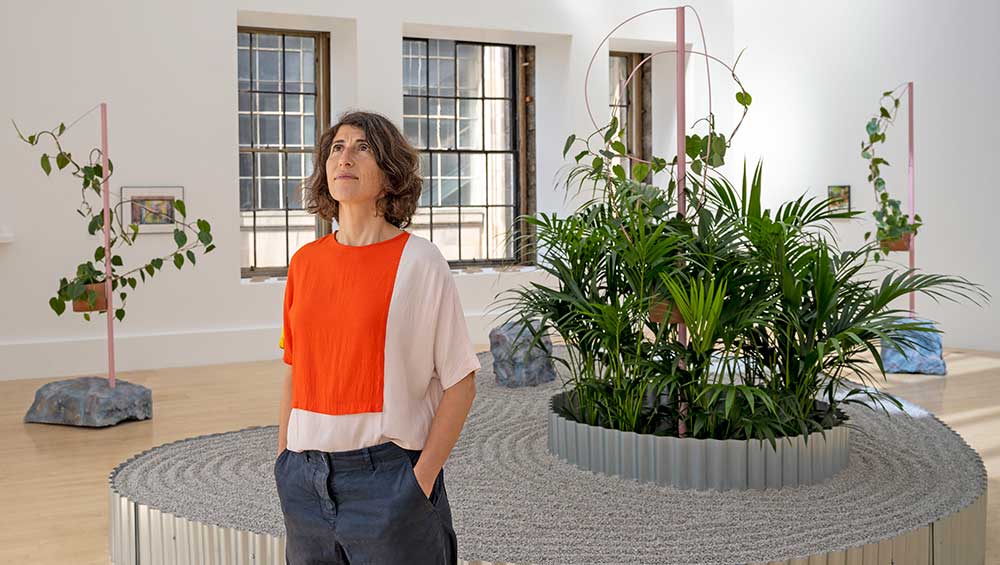
Céline Condorelli. Image courtesy the artist.
by VERONICA SIMPSON
Céline Condorelli’s first survey exhibition in the UK opened last month at the Talbot Rice Gallery in Edinburgh. It combines major new works and multiple installations, plus a wealth of materials, including drawings, maquettes and items from the gallery’s own collection – drawn from its partner institution the University of Edinburgh – to clarify, bolster and enrich the ideas behind Condorelli’s work.
Her explorations of space are informed by an experimental practice that began when she attended the Architectural Association School of Architecture in London in the 1990s. She reveals the constructed nature of our concepts around places for play or leisure and places for work, while documenting the labour that goes into these constructs. She uses the unusual, dual nature of the Talbot Rice Gallery (part white cube, part Georgian museum) to further probe that relationship, and all its complexities. The opening white cube gallery is transformed into a “garden as exhibition”, expanding her Zanzibar series (2018-ongoing), combining sub-tropical greenery, Brise-Soleil sunshades and ornamental rocks with her own models and drawings, plus a soundtrack “to let the city in”. We are then plunged into the claustrophobic atmosphere of a factory, with her Cotton/Rubber series, before encountering After Work (2022), the film she made in collaboration with the artist and film-maker Ben Rivers and the poet Jay Bernard, for a show of the same title at the South London Gallery. In the final Georgian gallery, we experience her immersive installation Thinking Through Skin (2021/2022), which is inspired by early alchemical colour experiments and the unique visual perception of cephalopods, parts of which appeared in the Nottingham Contemporary show Our Silver City, 2094 (2021/22). This gallery includes contributions from Condorelli’s artist friends, among them Anna Barham, Bernard, Revital Cohen, Tuur van Balen, Isa Genzken, Hannah Catherine Jones, James Langdon, Lucy Steeds and Grace Ndiritu.
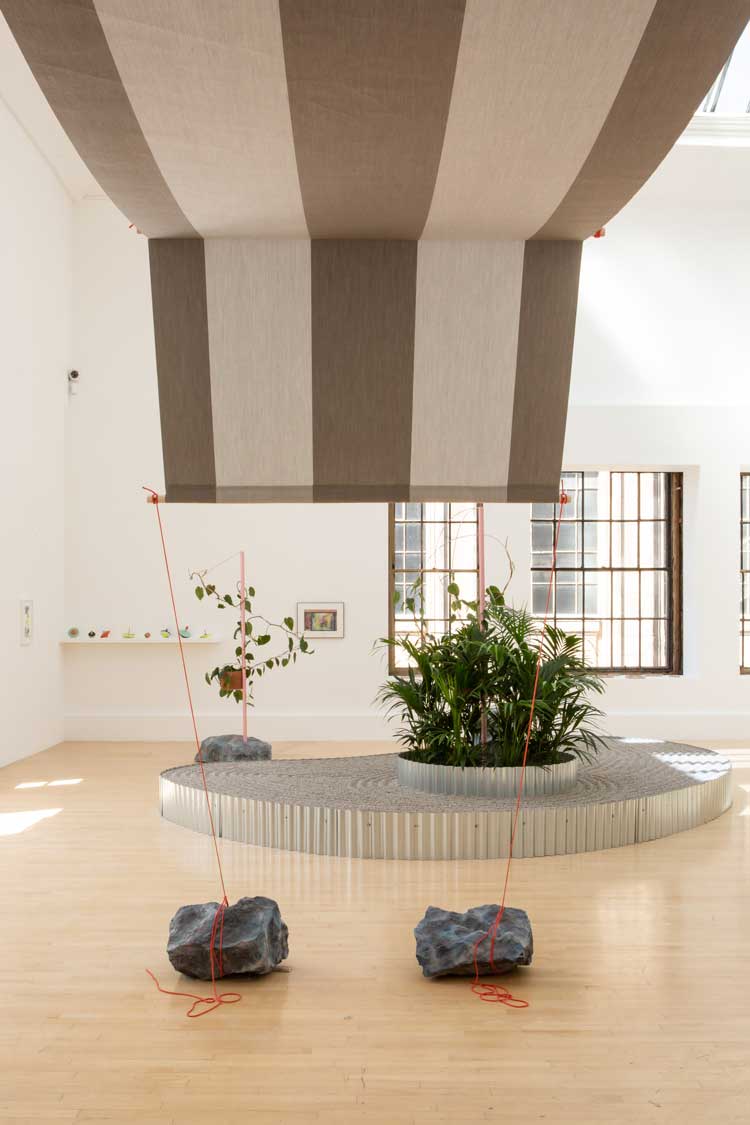
Céline Condorelli, Brise Soleil (2020), awning fabric, cotton rope. Installation view, Céline Condorelli: After Work, Talbot Rice Gallery, University of Edinburgh. Courtesy the artist and Talbot Rice Gallery. Photo: Sally Jubb.
Condorelli was born in Paris in 1974, but grew up in Florence, and says these complex, historic cities have influenced her work and thinking. She now lives in London. Recent exhibitions include After Work at the South London Gallery (2022); Conversation Piece (Spinning) at Remai Modern, Saskatoon, Canada (2022); Our Silver City, 2094, at Nottingham Contemporary (2021/22); Work, Work, Work (Work) at the Muzeum Sztuki, Łódź, Poland (2021); Two Years’ Vacation at FRAC Lorraine, France, and Tenerife Espacio de las Artes, Spain (2020); and Céline Condorelli, Kunsthaus Pasquart, Switzerland.
Veronica Simpson: I really enjoy the way that, although you trained as an architect, your practice seems to examine all the things that architecture doesn’t usually acknowledge, such as the quality and meaning of connecting spaces, especially the interstitial and neglected, overlooked spaces between buildings. But let’s dive into your Edinburgh show and how you have used those interrogations to explore this unusual space, the Talbot Rice Gallery, which is part white cube gallery and part Georgian natural history museum.
Céline Condorelli: I always pay a lot of attention to the existing conditions - the physical context you’re given when you start an exhibition – and how to use them rather than be subjected to them. I want to find interesting ways to use the architecture to tell the story, to take you through a narrative. It’s partly a methodology I have that Tessa [Giblin, director of the Talbot Rice Gallery] was also interested in – using the existing conditions rather than altering something that’s already there.
The space itself is split in two. As part of Edinburgh University, there’s the cultural heritage that we get because the Georgian gallery was once part of its natural history museum, and the architecture was listed, so it’s been left intact. This means you enter within a history of museums as well, which is really interesting. It’s rare that contemporary art gets exhibited in that kind of space.
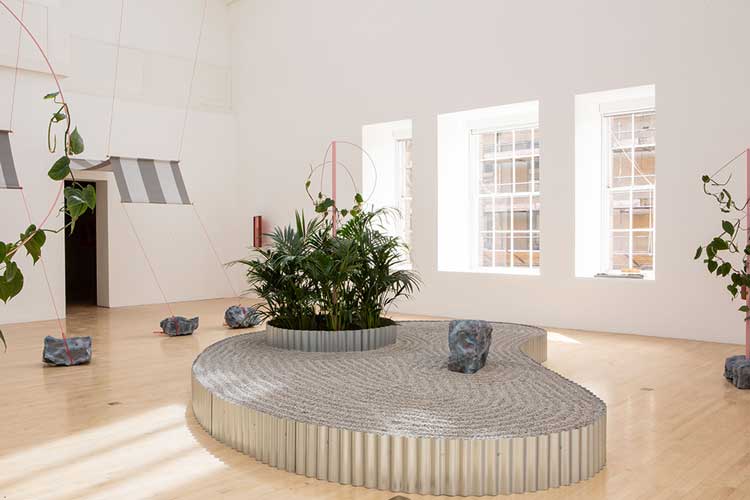
Céline Condorelli, Prologue, 2022, with Brise Soleil (2020), Props (2020–22), A Lot for a Little (2022), Alteration to Existing Conditions (windows). Installation view, Céline Condorelli: After Work, Talbot Rice Gallery, University of Edinburgh. Courtesy the artist and Talbot Rice Gallery. Photo: Sally Jubb.
Whether you’re entering a white cube, which is one extreme of a gallery, or the natural history museum, in both cases they are such strong formats, of exhibitions, of presentations of knowledge. In both cases, it’s very hard to escape how much the history of museums is a history of extraction, of alienation, of creating value in objects. Of course, that is incredibly present, whether you are looking at animal specimens or a white cube. I think the museum should not be abandoned, but it is nevertheless a polluted space in which I work and then I try and expose (the history) in a different way. With this context, it is possible to find ways of talking with this history in a non-exclusive way, and therefore acknowledge and even give a lot of attention and love to the things that are normally excluded from this kind of presentation – such as the people who make it possible, the people whose invisible labour is not usually recognised, and making sure all the technicians are named. The histories of work are really opened up in my work so that things are voiced and expanded, expanding forms of inclusion (through) specific, pragmatic gestures, I wanted to offer artworks that include seating, plants and the quantification of work.
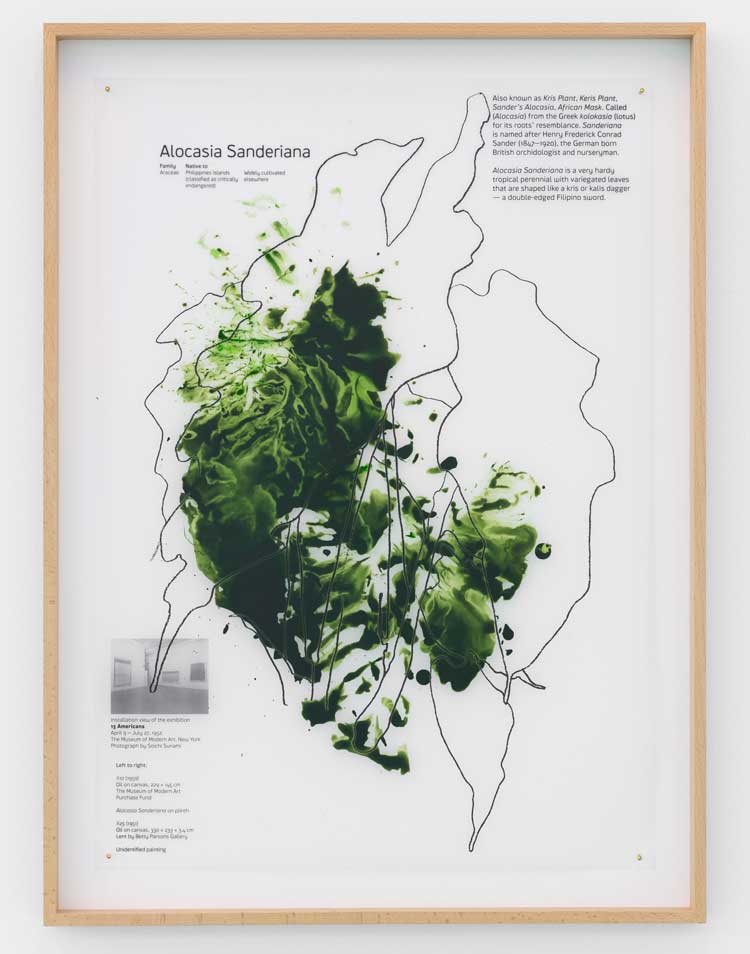
Céline Condorelli, Plant Studies, 2018. Wax print on drafting film, stained with watercolour and acrylic ink, 42 x 59.4 cm. Courtesy the artist. Photo: Bruno Lopes.
VS: I saw your film and installation, After Work recently, which was commissioned for the South London Gallery, and that is very much about the division between work and play, how spaces of play are made, and why and who makes them, as well as who uses them.
CC: The installation After Work, which is also the title of the show, is in the room that I think is called the Side Gallery - that strange, dark room where the lift arrives. In Italian we call it a posto sfigato (unlucky place). It is, literally, the victim of the remodelling of the gallery in the 1990s, a completely misled renovation in my view. Anyway, the film is a sort of reflection, a meditation, but a very close look at the labour involved in making a place for play. You never really see the finished playground clearly, just fragments of it. You see the things you don’t normally see – where the materials come from, the sheer amount of work that it takes and, especially, how the place changes through the accumulation of this labour. It’s set to this very strong voice, the voice of Jay Bernard talking about the relationship between play and housing, the place of play and childhood in relationship to somewhere like a housing estate and very much reflecting on the conditions of this place that would otherwise be invisible.
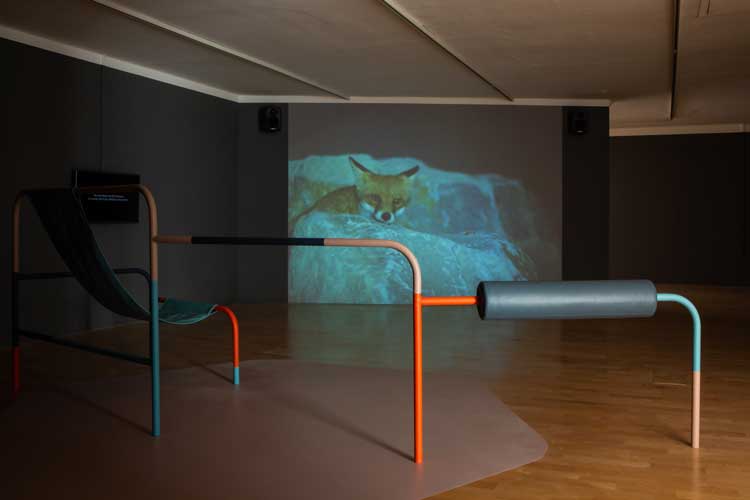
Céline Condorelli and Ben Rivers with Jay Bernard. After Work, 2021. Colour, sound, 16 mm transferred to HD, 12:55. Installation view, Céline Condorelli: After Work, Talbot Rice Gallery, University of Edinburgh. Courtesy the artist and Talbot Rice Gallery. Photo: Sally Jubb.
That, for me, is opening up this idea of the mirror: on one side is play and leisure, people go to somewhere like that after they finish work and pick up their kids. It’s an end-of-the-day place, always a negative or a positive of the time of work. So, you get to this room after having entered the white gallery, the entrance gallery, which we turned into a garden room, like a conservatory, we opened all the windows, it gets incredibly hot, and we have lots of tropical plants, it’s a space of leisure. The gallery beyond that, on the ground floor, is almost the opposite, entirely dedicated to a series of pieces I made in Turin, at a tyre factory, called Cotton/Rubber (2017). You go from the first, incredibly open space to this closed, claustrophobic space and that’s how you enter this installation. I liked that, in this way, we have opened up the idea of opposing worlds: both (these worlds) inhabit the world of culture, but what is free time when you’re in a museum? What is free time when you’re going to an exhibition? What does it mean, anyway? There are all these different spaces constructed to inhabit that notion of freedom – public parks, museums, galleries and then the world of factory work, which is still so influential in our idea of labour, though so few of us work like that.
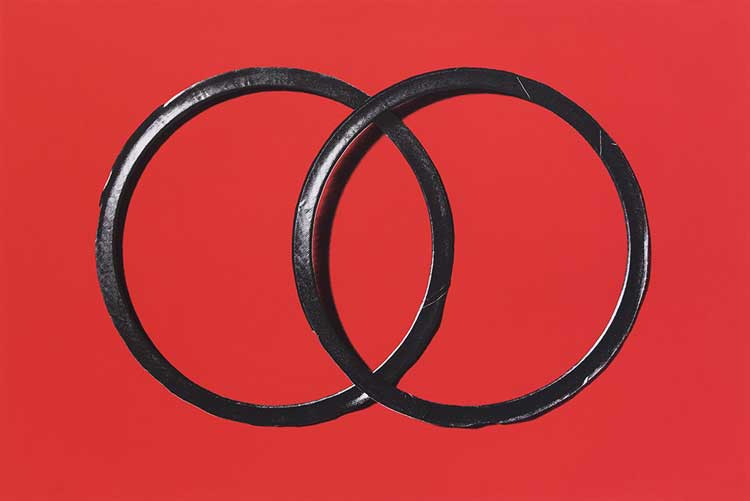
Céline Condorelli, Cotton/Rubber, 2017. Silkscreen, two colours on red paper. Courtesy the artist.
Then you get to After Work: you go up the stairs and come behind the screen, and you see the structure of the screen, and you realise you are behind the projection and there is this lovely climbing structure I had made that you can lean or sit on, which has a deckchair seat in it – though mostly people still don’t dare sit on it.
The chronology of this sequence is not particularly strict. The white gallery holds a lot of work, maybe the oldest is from 2014 and the most recent from this year. All the factory work is from 2014 and 2017. And then the installation After Work is very new. I was trying to create a structure around these storylines that deal with how we understand work and how we recognise labour, and make it somehow work through the spaces of Talbot Rice.
VS: Then there is a balcony that connects the white cube spaces to the Georgian area – a kind of crazy corridor, but with lots of acoustic bleed through from the first to the last spaces.
CC: Yes, you can hear the voice of Jay Bernard in After Work, and there’s a distant soundtrack from the white gallery and a very present soundtrack in the Georgian gallery. You do hear those voices mixing up. There are four framed works along this balcony from eight case studies around play, that are slightly older works that really place my own position in relationship to how the cultural institution welcomes or houses play. One was an idea by [the Brazilian modernist architect] Lina Bo Bardi that proposed a playground as being the responsibility of the museum. You also have the playgrounds of [the architect] Aldo van Eyck and his idea of the playable city, making the city fit for habitation in the wider sense rather than making separate spaces for children or for people to be at leisure in. It is definitely not the way things went, but it’s still an incredibly interesting and valid position today.
Then there is a large-scale drawing, which is called Limits to Play, featuring works I made in the last two years looking at the boundaries that exist within our understanding of free time. One part relates to the dates when women were first allowed to participate in particular sports. This is interesting as a reminder that all this focus on “play” - which could be viewed as a thing that is easy, fun, sweet, something to do with kids – includes the question of inclusion, which is very important and very complicated within what is considered play. And that continues today, with trans athletes being able or not able to compete. The terms of inclusion are infinitely sophisticated. There are always reasons why people can’t play.
VS: There is very interesting research into how public parks and spaces prioritise boys’ play over girls – incorporating football pitches or basketball courts as a default.
CC: This is a huge issue, the participation of women. There’s also this problem in schoolyards. It’s almost always football that takes up all the space, and almost always boys that play football. This piece (at Talbot Rice) comes from a larger-scale artwork that exists in a public exhibition version. It is currently installed in a school in northern France, and it comes with a consciousness-raising programme on gender equality and play - not for the kids but the teachers in the school, because it’s they who have to learn about it. Kids just need to be guided. It’s a double work, with this very graphic, very easy-on-the-eye installation. If they want the artwork in the school, they can have it free, but they must engage in a one-year programme on gender equality with the members of staff. Which, of course, is the most important bit.
VS: So, it is a participatory artwork, but with conditions attached?
CC: Yes, that’s the version for public space. The work in the Talbot Rice is a version of that.
VS: For the South London Gallery After Work commission, you installed a permanent playground nearby, on the Elmington Estate in Camberwell.
CC: They have such an amazing programme outside the gallery, but it’s the first time the gallery did something so big and so permanent. It was really complicated, and it was during Covid. I hope it’s making a bad situation a little bit better. It’s a particularly sad square in a particularly neglected housing estate. The playground is trying to offer something, some generosity to this place. The way that I involved Jay was that I asked if they would consider writing a poem for this place. I can’t change or fix half a century of historical neglect, but I could create a situation in which this place has a poem attached to it, which is such a beautiful thing. Jay is an incredible poet. And this spoken word piece became the soundtrack to this geographical place.
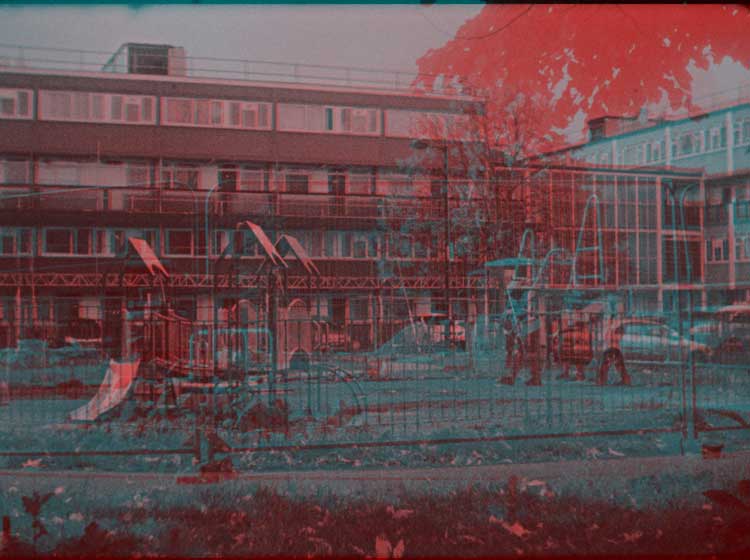
Céline Condorelli and Ben Rivers with Jay Bernard. After Work, 2021, film still. Colour, sound, 16mm transferred to HD, 12:55. Courtesy the artists.
VS: I liked the way there was such a layering of imagery and sound and texture in the film.
CC: The juxtapositions are both where really physical images are overlaid, and also typological, layering different types of sounds and images together. It was interesting to explore this in moving image, as I’ve never made films before, and I’m not really an image-maker. However, the few images that I have done, or presented in the [Talbot Rice] exhibition, mostly use a process I call colour separation as a way of talking about time. Over a long period, I developed this idea of colour separation with James Langdon, a graphic designer. Using the CMYK [cyan, magenta, yellow, key/black] colour process and expanding it in time, you get a composite image that corresponds to a period of time. C, M, Y, K: four different exposures in four different colours that are not accurate depictions of what you see, but are really accurate depictions of what’s happened. It’s an overlay of things. I take this quite seriously as a methodology in a wider sense. Things that aren’t present visually are present in other ways. A lot of the sounds you hear in After Work are the sounds of machines that were used, the concrete mixer for example, the explosion at the quarry when the rocks that became jumping blocks in the playground were blown out. I’m trying to draw out the process of going from raw material to artwork, with all the people along the path and everything that happened in between. I’m trying to demystify this process of creation somehow, because it is constructed by small things, one after another.
VS: You initially trained as an architect. How does that inform your work?
CC: I studied at the Architectural Association in London, but I didn’t finish. I went in the early 1990s and did my RIBA Part 1. I had a really great time, it was a great school for me, very interesting with very interesting teachers. I often think it saved me from being a boring, middle-class Italian. I’m exaggerating a little bit, but it was definitely a place in which experimentation and learning by trial and error was extreme. There was very little academic teaching. I come from a very academic family and it was wonderful to discover this other way of being, but I didn’t design a single building during my entire architectural training, which I don’t think is possible any more. My diploma consisted of 10 films of one minute each about the perception of time in London, which I don’t think would be acceptable now. I did study architecture, I really enjoyed it and I learned a lot. I think my capacity to work with space, my ability to think of space as an ingredient, as the primary material, comes from that. Even though I don’t apply it to architecture, it’s given me an incredibly interesting set of tools and methodologies.
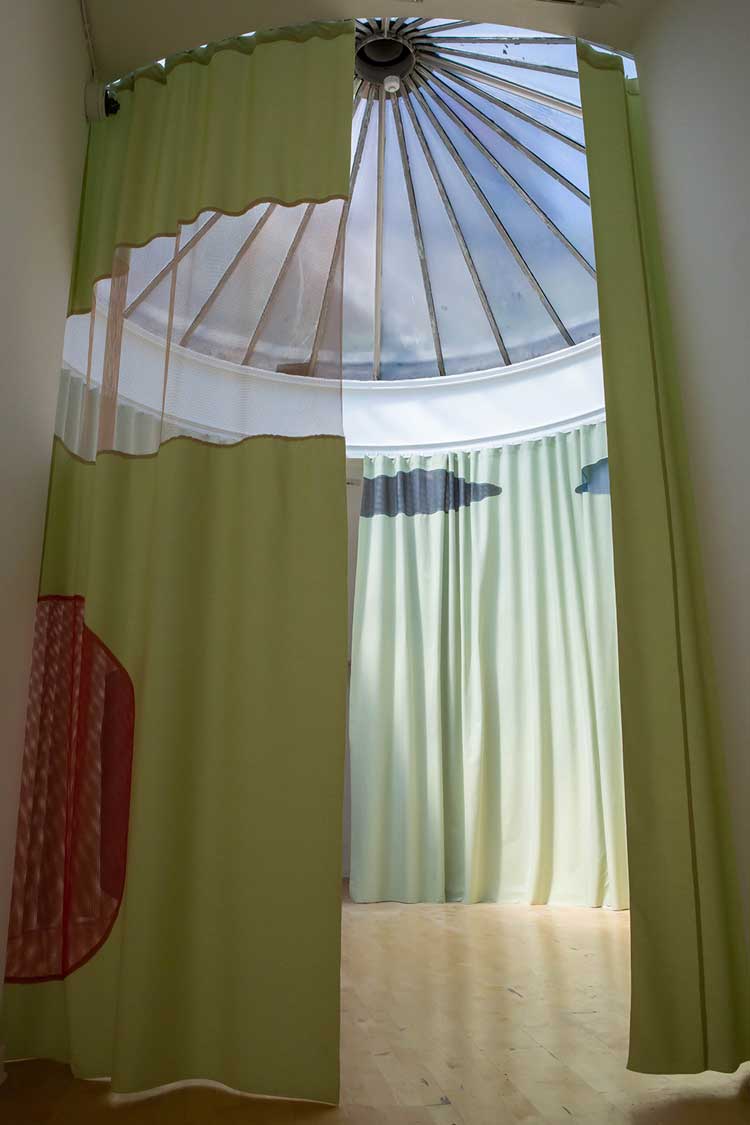
Céline Condorelli, Host, 2019. Fabric. Installation view, Céline Condorelli: After Work, Talbot Rice Gallery, University of Edinburgh. Courtesy the artist and Talbot Rice Gallery. Photo: Sally Jubb.
VS: Getting back to Edinburgh, let’s complete our journey into the Georgian gallery.
CC: Before you get to the Georgian gallery, there is a room with a big skylight. In terms of the installations, that is now my favourite. I needed it to work as a portal, a threshold between the two halves, the old and the new, one type of museum and another type of museum, but also one type of body of work and another very different type of body of work. I installed a curtain called Host. You enter and you’re inside the work. It’s a large-scale curtain work: it’s like a large painting, it’s colourful and full of windows and you see the sky suddenly, and it completely reframes your own perception of where you are before you get into the cabinet space [balcony] of the Georgian gallery.
VS: There was a curtain work in Our Silver City at Nottingham Contemporary.
CC: That’s in the Georgian gallery. It’s an expansion on my installation at Nottingham Contemporary. And some work has changed. It’s expanded, but it is very much the same installation. That includes [work by] Tuur van Balen and Revital Cohen, the soundtrack by Hannah Catherine Jones and the film by Ben Rivers. The film by Grace Ndiritu, which was in the introduction, has now replaced the work by Cauleen Smith: this was to do with wanting to acknowledge how this exhibition was partly developed with Grace, and Grace was really important for me in our dialogue over the last two years, so it made sense to integrate her film. And, also, because years ago I curated an exhibition called Curtain Show, which invited Grace, and that’s when we started our dialogue. But in the upstairs of the Georgian gallery, I used this long balcony with all the little alcoves for their original purpose – as small exhibition vitrines. I would almost call it extended captions. Tessa [Giblin] calls it the Research Base. All the elements of the exhibition are opened up in terms of context, how they relate to the process, and the references around them – the elements of play from the South London Gallery, my collection of spinning tops. There’s a lot of my thinking about the entire show, including six bays that relate directly to what’s happening downstairs. But it was a huge amount of work. It was like having a show within the show, with multiple loans and things that needed particular kinds of temperature control. I think it just about killed us. It’s a very generous way to offer an exhibition that is a solo show, because it opens a world of connections. You can run through the exhibition in 20 minutes, but you can also spend an hour and a half in there, no problem. That I think is a really good format.
I think part of my talent is not that I make beautiful objects – though some of my objects are beautiful – but I can really create connections, I can narrate very complex things in simple ways, I can make links between very theoretical ideas and very practical ones, to dialogue with space. Those are the things that I do well.
VS: What’s next for you? What else is in store for this year?
CC: I’m having a break from exhibitions. I have done five shows this spring, and two public art commissions and I am literally flat. Also, I decided to go back to teaching, not because I don’t have any work on, but because I miss teaching. I’ve taken a teaching job in Karlsruhe at the School of Art and Design, which is attached to ZKM (centre for art and media). I start in July.
I am working on three longer-term projects that will not have exhibitions until next year, autumn 2023. One is a long-term research project I’ve been doing in Morocco with the anti-colonial art school called the School of Casablanca. I’m focusing on abstraction as female labour – through crafts and weaving. And there’s going to be series of events this autumn and an exhibition next year. It’s a new body of work. I’m also doing a public art commission in Antwerp, which is in construction. I’m doing something in the middle of the city. There’s this massive car park in front of the Museum of Contemporary Art that’s going to be turned into a park, 1km long, and I’ve got three little pockets there. I’m quite excited about that.
• Céline Condorelli: After Work is at the Talbot Rice Gallery, Edinburgh, until 1 October 2022.